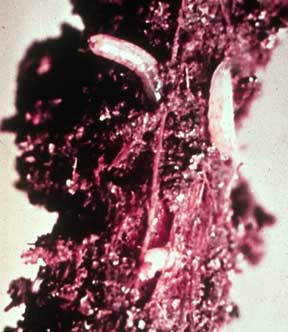Early season insect pests: the maggots
Editor’s note: This article is from the archives of the MSU Crop Advisory Team Alerts. Check the label of any pesticide referenced to ensure your use is included.
Early season maggot flies (onion, cabbage and seed corn) are active and laying eggs. These insects are adapted to cool weather; they are more of a problem early in the season. Adult flies look similar to small houseflies. They are very mobile and do not spend much time in the field. Control methods should be directed toward protecting seeds, seedlings and young plants.

Cabbage maggots.
Seed corn maggots feed on a variety of vegetable crops, including corn, beans and vine crops. They are the most cold tolerant of the three maggot species and, therefore, appear earliest in the season. Seed corn maggots cause more problems during extended periods of cool, wet weather, in soils with high organic matter, and when green manure has been recently incorporated. Simply delaying planting until the soil warms, and waiting a week or so after turning over green manure, will reduce damage. Planting insecticide-treated seed will also control seed corn maggot.
Cabbage maggot flies lay eggs at the base of young cole crops. Adult cabbage flies first become active and lay eggs in the spring about the time yellow rockets bloom. The next generation of flies begins to lay eggs about the time daylilies bloom. Damage can be reduced if growers are able to wait until the soil warms in the spring to plant and avoid planting during peak egg-laying periods. Insecticide treatments at planting or transplanting will also reduce injury. See MSUE Bulletin E-312: 2007 Insect, Disease and Nematode Control for Commercial Vegetables for insecticides registered for control of cabbage maggot on different crops.
Onion maggot flies lay eggs at the base of onion plants. Upon hatching the small maggots feed on the plant roots, causing wilting and seedling death. The first generation of maggots cause the most damage. Rotating fields and eliminating cull piles (in which onion maggots overwinter) can reduce onion maggot populations. Using treated seed (Trigard), or applying Lorsban at planting will protect young onion plants. Both Lorsban 15G and Lorsban 4E is registered as an at-plant treatment for onion maggot. In addition, Lorsban 4E can be used as a post-planting drench spray, although drench treatments are not as effective as at-plant treatments for control of onion maggot. See MSUE Bulletin E-312: 2007 Insect, Disease and Nematode Control for Commercial Vegetables. The at-plant treatment for Lorsban 4E was inadvertently left out of this bulletin—the rate is 1.1 fl oz/ 1,000 row feet (based on 18 inch row spacing--see label for directions).



 Print
Print Email
Email


